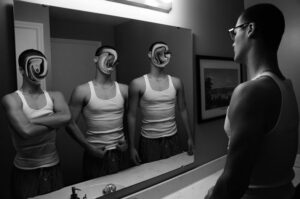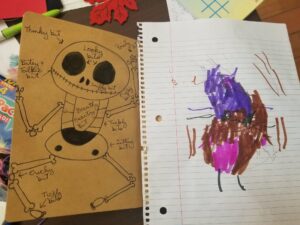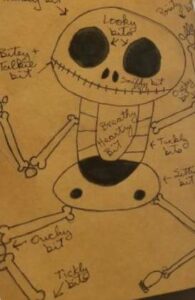I have struggled with how to incorporate graphics into the English curriculum. Literature and visual texts make up the majority of the curriculum with the odd ‘presentation’ assignment. This has been changing with the introduction of the Core Competencies with little focus on the grade level at which students can read and write. The difference in reliable technology access from my previous district is also having an effect. I want to make sure that the presentations of learning are relevant to the curriculum and to students, not busy work.
Activity 2: Source graphics for educational use

SONY DSC
http://commons.wikimedia.org/wiki/File:Identity-Persona.jpg
Creative Commons Attribution-Share Alike
Learning outcome: Construct meaningful personal connections between self, text, and world
How does the graphic support the learning outcome: Students would be given the opportunity to describe what they think the image means and the connections they can make between it, themselves, other texts and the world. Guiding questions could include:
- Describe what is happening in this image. (Minimum 5 sentences)
- What is going through the mind of the person looking in the mirror?
- What connections to your own life can you make to this image?
- What other media connects to this image?
- How does this image fit into our study of identity?
This image could be modified to focus on specific aspects of it, but it could easily be used as is.
Links to readings: I feel that this image is descriptive as its purpose is to trigger a response from viewers and representational of the big idea of the class – identity (Clark and Lyons, 2010). It is also perceptual as students are tasked with creating their own interpretation of what the image means (Schnotz, 2022).
Activity 3: Crop, Rotate, Resize and Thumbnail a photo
All modifications to this personal photo of a ‘creative’ anatomical infographic were completed using Photopea. This software functions very much like PhotoShop. This graphic would be used as an example of a different form of infographic, focusing on an image rather than text for English 11, English 11 First Peoples, English 12 and English 12 First Peoples.
Original

Cropped and rotated version

Cropped to remove superfluous material within the picture.
Rotated with Hand Tool to center the image.
Thumbnail Resizing

Opacity dropped to 80% from 100% in order to make the contrasting white text pop. The image was resized to 108 by 108 px. I chose to focus on the black eyes and face to grab the viewer’s attention.
References
Clark, R. C. & Lyons, C. (2010). Three views of instructional visuals. In R. Taff (Ed.), Graphics for learning: Proven guidelines for planning, designing and evaluating visuals in training materials (2nd ed., pp. 15–28). Pfeiffer.
http://ezproxy.tru.ca/login?url=https://ebookcentral.proquest.com/lib/trulibrary-ebooks/reader.action?docID=624441&ppg=37
Mounce, Kate-Nicola. Photograph of Draw a skeleton and label it wrong. 6 Apr. 2020. Author’s personal collection.
Schnotz, W. (2022). Integrated Model of Text and Picture Comprehension. In R.E. Mayer & L. Fiorella (Eds.), The Cambridge Handbook of Multimedia Learning (pp. 82-99). Cambridge University Press.
https://www-cambridge-org.ezproxy.tru.ca/core/books/cambridge-handbook-of-multimedia-learning/integrated-model-of-text-and-picture-comprehension/984E5EBEFF5D53F5DD8BDA62F6A60718

Leave a Reply
You must be logged in to post a comment.